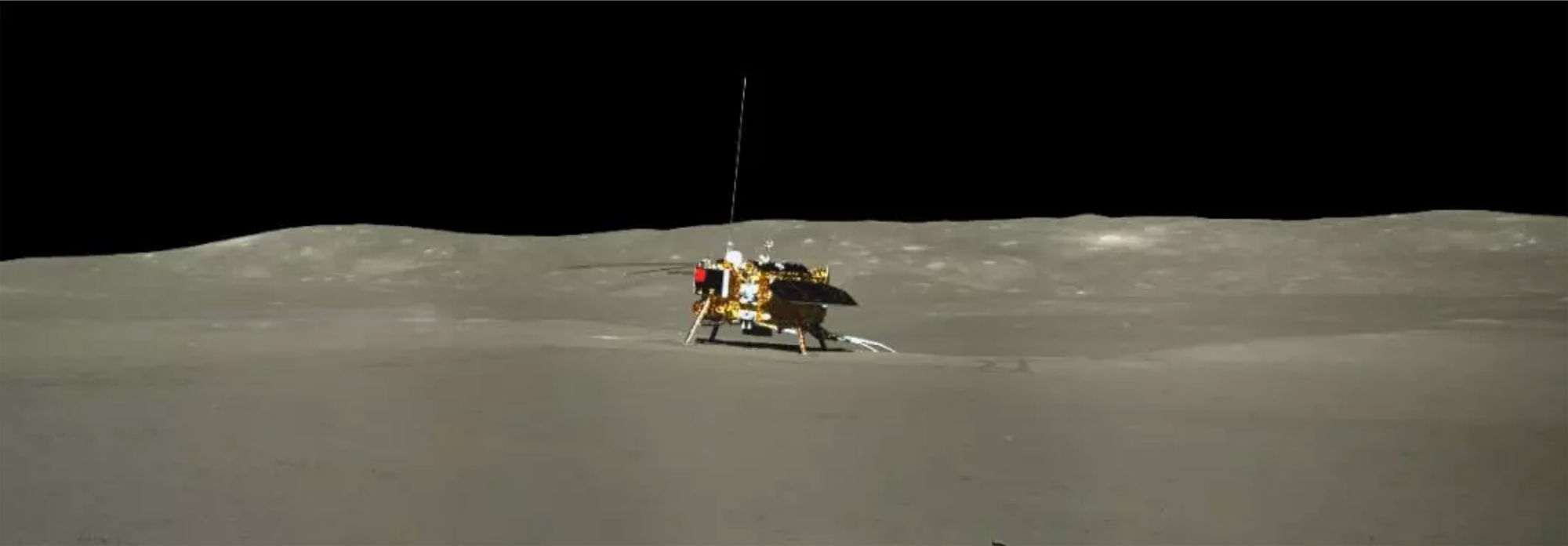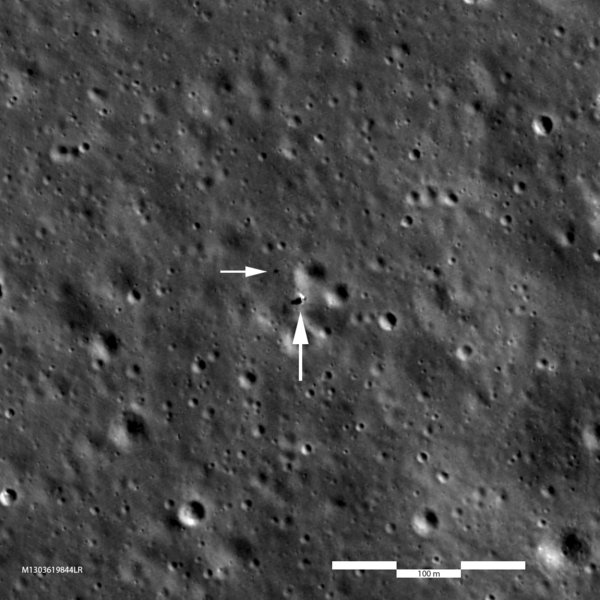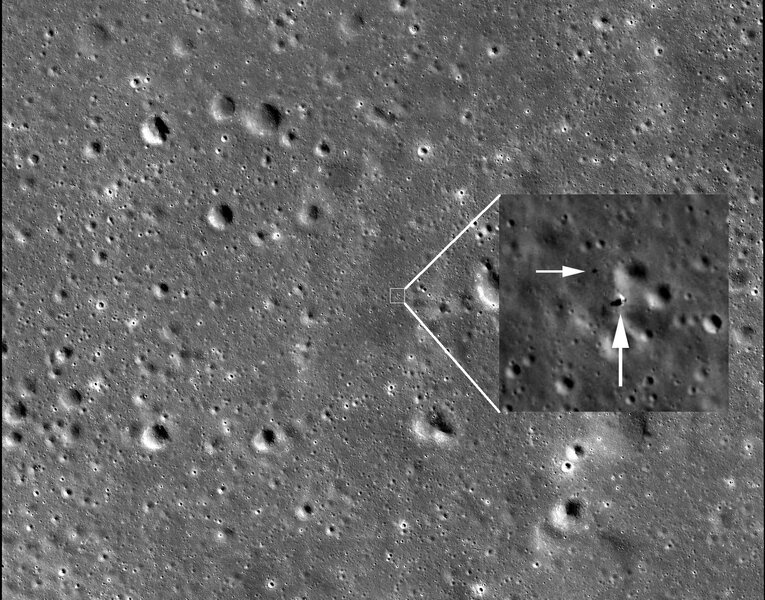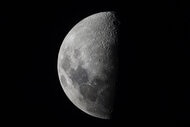Create a free profile to get unlimited access to exclusive videos, sweepstakes, and more!
UPDATE: LRO looks down on Chang'e-4. *Straight* down.

A little over a week ago, I showed y'all a pretty cool image: The Chinese Space Agency's lunar lander and rover, Chang'e-4 and Yutu-2, as seen from orbit by NASA's Lunar Reconnaissance Orbiter.
In that image, LRO's orbit put it about 330 kilometers east of the lander (plus dozens of kilometers up above the surface), so it had to tilt way over to the side to see it, and the resulting shot was taken at a pretty steep oblique angle. Because it was so far away, even LRO's powerful cameras couldn't see the hardware as much more than a teeny dot.
However, as LRO circles the Moon, the territory it sees changes — I'll explain in a sec, because that's really cool — and therefore so does its distance from the lander. That earlier image was taken on January 30, 2019. A couple of days, on February 1, LRO passed directly above Chang'e-4 and Yutu-2, sliding over the landing site at an altitude of 82 kilometers.
That changes things a lot. Here's what LRO saw when it looked straight down on the Chinese hardware:
Ah, that's better.
Although you can't see fine details — 82 klicks is still a fair hike — the lander appears much bigger, spanning several pixels. At that height, each LRO pixel is about 0.85 meters in size (about the size of a standard push lawnmower; it's hard to think of analogies that are easy to grasp sometimes!), and the lander is roughly a couple of meters across (I actually can't find good numbers for this, so if anyone knows let me know!). The rover is smaller, about 1.5 meters by 1 x 1, and can be seen to the upper left of the lander. It was just under 30 meters from the lander when this image was taken.
I have to once again note how amazing it is that we can get these sorts of shots. The lunar landscape is vast, and doesn't have the same sort of landmarks we have on Earth. This area of the Moon's far side has craters ranging in size from too small to see to many thousands of meters across. There are rocks, and mounds, and hummocky hills, and, well … that's about it. If you're not familiar with the terrain* then it's easy to get hopelessly lost.
Don't believe me? I went to the LRO blog and downloaded the gigantic full-resolution mosaic LRO took as it passed over the Chang'e-4 site and poked around trying to find the lander … then laughed when I saw the LRO folks had already highlighted the site by putting a square around it. If they hadn't done that, I never would have found it.
Here's the image with the landing site outlined. I cropped the close-up from above to match the square and inserted it into the shot:
Yeah, see what I mean? And it's even worse: I shrank the original high-res image by a factor of five to make this image. The original has even more detail, making it that much harder to find an individual speck. That strip shows a region of the Moon about 8.5 kilometers wide, and before I cropped it was about 50 kilometers in length. Imagine finding something a few meters across in all that!
Now, there are some tricks. For one thing we already knew where the lander was, so that shrank the region of interest considerably. But there's something else, too: shadows.
Note the shadowing on the craters. Because the Sun is coming from the upper right of the image, the craters are shadowed at the top right and lit at the bottom left. But now look at the lander: It's bright on top, and shadowed on the bottom! That makes it stand out more easily amongst the craters. Otherwise, yikes. Good luck finding it.
So why does the angle change between LRO and Chang'e-4? It's because of the orbit. When a satellite orbits a world, it's orbiting the center of that world. All it cares about is the gravity it feels, and that comes from the mass of the object it's orbiting. It doesn't care if the object is rotating or not.
The plane of that orbit is pretty much fixed in space. So if it's, say, due north/south with respect to the Moon, it'll stay that way. If the Moon didn't spin, LRO would pass over the exact same spots on the Moon over and over again. But the Moon does spin, about once per month, so every orbit LRO passes over different spots as the Moon rotates beneath it. The actual math is a bit complicated because the LRO orbit is influenced by lots of other factors, but in the end what this means is that over time LRO passes over the entire surface Moon, one swath at a time.
That's why it was over to one side of Chang'e-4 in late January, then directly over it in early February. By now, LRO is far to the west of that site, and it'll be a while before the Moon spins enough to put the Chinese site under LRO's direct gaze once again. By then the lighting will have changed, too, so the shadows will be different as well. It should be interesting in a few weeks to see the new images of it!
I'll note that LRO makes mineralogical maps of the Moon as well, so this helps the science, putting the measurements taken by the lander and rover into broader geologic context, much as the image itself does. That's why we send different missions to other worlds; they each do their own thing, but when you add them together you get more then just the sum of their parts.
You get to understand a world. I think that's very much worth the effort.
*I use that word loosely, since it's based on the word terra, for Earth. But lunain looks weird.
[Correction, Feb. 19, 2019: I originally wrote that LRO passed over Chang'e-4 on Feb. 7.]

















